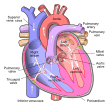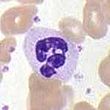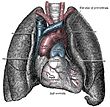Human body facts for kids
The human body is like an amazing machine that helps us live, move, and think! It's made of many tiny parts called cells. These cells work together to form tissues, and tissues then create organ systems. All these parts work in harmony to keep our body healthy and working properly.
Our body has a head, a neck, a main part called the trunk (which includes our chest and belly), arms with hands, and legs with feet.
Contents
- What the Human Body is Made Of
- How Our Body is Built: Anatomy
- How Our Body Works: Physiology
- How We Grow and Change: Development
- Studying the Human Body
- Fields of Study
- The Human Body and Other Animals
- Images for kids
- See also
What the Human Body is Made Of
Our bodies are made up of different elements. These include hydrogen, oxygen, carbon, calcium, and phosphorus. These elements are found inside trillions of cells and other parts of our body.
A grown-up male body is about 60% water. That's about 42 liters of water! This water is found both inside and outside our cells. The body works hard to keep the right amount and balance of water everywhere. Important chemicals like sodium, chloride, and potassium help keep this balance.
Tiny Building Blocks: Cells
Our body has trillions of cells, which are the basic units of life. Scientists estimate we have about 30 to 37 trillion cells! We also have about the same number of non-human cells, like the helpful bacteria living in our gastrointestinal tract (gut) and on our skin.
Not every part of our body is made of cells. Cells sit in a special material called the extracellular matrix. This matrix is made of proteins like collagen and is surrounded by fluids. For example, bones and connective tissues are mostly non-cellular material.
Our Body's Instruction Manual: Genome
Cells in our body work because of something called DNA. Think of DNA as the instruction manual for our body. It's found inside the nucleus of most cells.
Parts of the DNA are copied into RNA. This RNA then travels out of the nucleus to help create proteins. Proteins are like tiny machines that do all the work in our cells. They control how cells function and what they produce. For example, red blood cells lose their nucleus and DNA when they grow up.
Working Together: Tissues
Our body has many different types of tissues. A tissue is a group of cells that work together to do a specific job. Studying tissues is called histology, and it often involves looking at them under a microscope.
There are four main types of tissues:
- Lining cells (epithelia): These cover surfaces, like our skin or the inside of our stomach. They control what goes in and out, protect our insides, and help us feel things.
- connective tissue: This tissue supports and connects other tissues and organs.
- Nerve tissue: This tissue carries messages around our body.
- Muscle tissue: This tissue helps us move.
Body Parts with Jobs: Organs
Organs are groups of cells and tissues that work together to do a specific job. Most organs are inside our body, but our skin is also a very large organ!
Examples of organs include the heart, lungs, and liver. Many organs are protected inside special spaces in our body called cavities. For instance, our stomach is in the abdomen, and our lungs are in the pleural cavity.
Body Systems: Teams of Organs
Our organs work together in teams called systems. Each system has a big job to do to keep us alive and healthy.
The Circulatory System
The circulatory system is like our body's transportation network. It includes the heart and all the blood vessels (like arteries, veins, and capillaries). The heart pumps blood, which carries oxygen, nutrients, and fuel to every part of our body. It also picks up waste products.
Blood travels in two main paths:
- The pulmonary circuit sends blood to the lungs to pick up oxygen and drop off carbon dioxide.
- The systemic circuit sends oxygen-rich blood from the heart to the rest of the body.
Blood also carries special cells that help fight off sickness.
The Digestive System
The digestive system breaks down the food we eat into tiny, useful pieces. These pieces, called molecules, can then be absorbed into our body for energy and growth.
This system includes:
- Our mouth (with our tongue and teeth)
- The esophagus (food pipe)
- The stomach
- The small and large intestines
- The rectum
- Other helpers like the liver, pancreas, gallbladder, and salivary glands.
Digestion starts in the mouth, where we chew food. Then, we swallow it, and it moves down the esophagus to the stomach. In the stomach, food mixes with special acids to get out the nutrients. What's left moves to the small intestine, where more nutrients and water are absorbed. Finally, the remaining waste goes to the large intestine to form feces, which are stored in the rectum until they leave the body.
The Endocrine System
The endocrine system is like our body's messaging system. It uses special chemical messengers called hormones. These hormones are made by endocrine glands like the pituitary, thyroid, adrenals, and pancreas.
Hormones travel through our blood to send signals from one part of the body to another. They control many things, like our growth, how we use energy, and how our body responds to stress.
The Immune System
The immune system is our body's defense team. It protects us from germs, viruses, and other harmful things. It includes white blood cells, the thymus, lymph nodes, and lymph channels.
This system helps our body tell the difference between our own healthy cells and outside invaders. It then uses special proteins, like antibodies, to neutralize or destroy the harmful substances.
The Integumentary System
The integumentary system is the covering of our body. It includes our skin, hair, and nails. It also has important parts like sweat glands (which help cool us down) and sebaceous glands (which make oil for our skin).
Our skin protects our internal organs, helps us feel things, and keeps everything inside our body.
The Lymphatic System
The lymphatic system is a network that collects and moves a fluid called lymph. Lymph is found between our cells. This system is similar to the circulatory system because it also carries fluid around the body. It plays a big role in our immune system too.
The Musculoskeletal System
The musculoskeletal system gives our body its basic shape and allows us to move. It's made of:
Besides helping us move, our bones also have bone marrow, where blood cells are made. Bones also store important minerals like calcium and phosphate. This system can be thought of as two parts: the muscular system and the skeletal system.
The Nervous System
The nervous system is our body's control center. It's made of tiny cells called neurons, which form nerves and ganglia. These connect to form the brain and spinal cord.
The brain is where we think, feel emotions, remember things, and process what we see, hear, taste, and smell. It controls many of our body's functions. Our eyes, ears, tongue, and nose gather information about the world around us.
The nervous system has two main parts:
- The central nervous system (CNS): This includes the brain and spinal cord. It's in charge of organizing movement, processing sensory information, thinking, and memory.
- The peripheral nervous system (PNS): This includes all the nerves outside the brain and spinal cord. It gathers information from our senses and tells our muscles what to do.
There are also two functional parts:
- The somatic nervous system (SNS): This controls voluntary actions, like speaking or moving our arms.
- The autonomic nervous system (ANS): This controls involuntary actions, like digestion and regulating our blood pressure.
Sometimes, the nervous system can have problems. For example, in epilepsy, abnormal brain activity can cause seizures. In multiple sclerosis, the body's own immune system attacks the nerve linings, making it hard for nerves to send signals.
The Reproductive System
The reproductive system is responsible for creating new life. It includes the gonads and other internal and external parts. This system produces special cells called gametes. In females, it also provides a safe place for a baby to grow for about 9 months before birth.
The Respiratory System
The respiratory system helps us breathe. It brings oxygen from the air into our body and gets rid of carbon dioxide and water vapor. It includes our nose, nasopharynx, trachea (windpipe), and lungs.
When we breathe in, our diaphragm moves down, pulling air into our lungs. The air goes into tiny sacs called alveoli. These alveoli are surrounded by tiny blood vessels called capillaries. Oxygen from the air moves into our bloodstream, and carbon dioxide moves from the blood into the alveoli to be breathed out.
Problems like inflammation or too much mucus can make breathing hard. asthma causes the airways to be inflamed, leading to wheezing. Pneumonia is an infection in the alveoli.
The Urinary System
The urinary system cleans our blood. It includes the kidneys, ureters, bladder, and urethra. The kidneys filter out harmful materials from our blood to make urine. Urine carries waste, extra ions, and water out of our body.
How Our Body is Built: Anatomy
Anatomy is the study of the shape and structure of the human body. Our body has four limbs (two arms and two legs), a head, and a neck that connects to our torso.
Our body's shape is set by a strong skeleton made of bones and cartilage. Around the skeleton, we have fat, muscles, and organs. The spine (backbone) protects the spinal cord, which is a bundle of nerves connecting our brain to the rest of our body.
Blood vessels carry blood all over our body, pumped by the heart. Veins collect blood that has less oxygen from our tissues. This blood goes to the heart, then to the lungs to get oxygen. After getting oxygen, it goes back to the heart and is pumped through arteries to all parts of the body again. Blood carries oxygen, waste, and hormones. Our kidneys and liver help filter the blood.
Our body has different cavities, which are separate areas that hold different organ systems. For example, the brain is protected in the skull, the lungs are in the pleural cavity, and the intestines and liver are in the abdominal cavity.
Our height, weight, and shape are different for everyone and change as we grow and age. Our body shape is also affected by how much muscle and fat tissue we have.
How Our Body Works: Physiology
Physiology is the study of how the human body works. This includes how our organs and cells function mechanically, physically, and chemically when we are healthy. Our body has many systems that work together. They help keep our body in a stable state, called homeostasis. This means keeping things like sugar and oxygen levels in our blood just right.
Every system helps with homeostasis. For example, the nervous system and endocrine system work together as the neuroendocrine system. The nervous system sends messages using electrical signals, while the endocrine system uses hormones. Together, they control things like blood flow, posture, energy, temperature, and the body's acid balance.
How We Grow and Change: Development
The development of the human body is the process of growing to maturity. It starts when an egg from a female is joined by a sperm. The fertilized egg then grows in the uterus, first as an embryo and then a fetus, until birth.
Growth and development continue after birth, through childhood, adolescence, and adulthood. This process, called aging, is influenced by our genes, hormones, and the environment around us.
Studying the Human Body
Many people study the human body. They compare it to other animals, both living ones and extinct ones like other hominids (early human relatives like Neanderthals). Some study how the human body works and interacts with its environment. Artists also study the human body to draw or paint it.
Fields of Study
Many different areas of study focus on humans:
- Biology is the science of living things. It looks at how the human body works, how it changed through evolution, and how genetics influences it.
- Physical anthropology compares humans to other hominids and studies their bodies. They look at how humans and chimpanzees are similar or different.
- Psychology is a field of medicine that looks at how people think and feel. Since our brain is part of our body and controls our thoughts and feelings, psychologists study how the brain makes us who we are.
- Medicine treats the body like a complex machine. Doctors study how to fix problems, called diseases, to help people stay healthy.
All the different organ systems work together to allow our body to live and do amazing things.
The Human Body and Other Animals
The human body shares many similarities with other animals. Our skeleton, muscles, and other parts are very much like those of other primates. We are also similar to other mammals and even other vertebrates (animals with backbones). Our DNA also shows these connections: the human genome is most similar to other primates, especially chimpanzees.
Images for kids
See also
 In Spanish: Cuerpo humano para niños
In Spanish: Cuerpo humano para niños

















